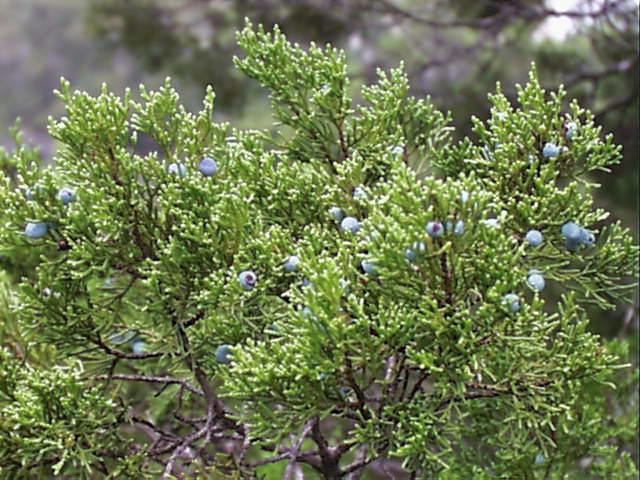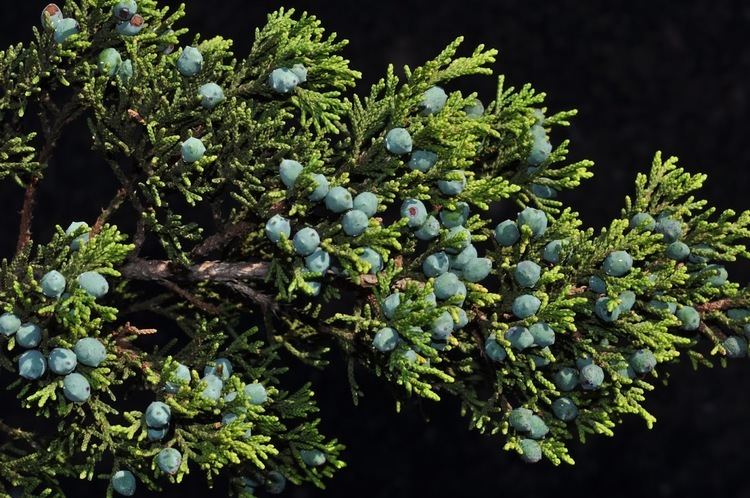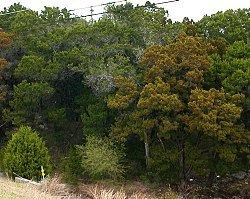Order Pinales Higher classification Juniper | Division Pinophyta Scientific name Juniperus ashei Rank Species | |
 | ||
Similar Juniper, Juniperus pinchotii, Golden‑cheeked warbler, Juniperus monosperma, Juniperus virginiana | ||
Ashe juniper juniperus ashei moderate flammability shrub
Juniperus ashei (Ashe juniper, post cedar, mountain cedar, or blueberry juniper) is a drought-tolerant evergreen tree, native to northeastern Mexico and the south-central United States north to southern Missouri; the largest areas are in central Texas, where extensive stands occur. It grows up to 10 metres (33 ft) tall, rarely 15 metres (49 ft), and provides erosion control and year-round shade for wildlife and livestock.
Contents

The feathery foliage grows in dense sprays, bright green in color. The leaves are scale-like, 2 to 5 millimetres (0.079 to 0.197 in) long, and produced on rounded (not flattened) shoots. It is a dioecious species, with separate male and female plants. The seed cones are round, 3 to 5 millimetres (0.12 to 0.20 in) long, and soft, pulpy and berry-like, green at first, maturing purple about 8 months after pollination. They contain 1-2 seeds, which are dispersed when birds eat the cones and pass the seeds in their droppings. The male cones are 3–5 mm long, yellow, turning brown after pollen release in December to February.

Allergy

The pollen causes a severe allergic reaction for some people in the winter, and people who are allergic to Ashe juniper are also often allergic to the related Juniperus virginiana. Consequently, what begins as an allergy in the winter may extend into spring since the pollination of J. virginiana follows that of J. ashei. Ashe juniper is sometimes known in the area as "mountain cedar" (although neither it nor J. virginiana are cedars), and locals usually refer to the allergy as cedar fever. Left untreated, symptoms of cedar fever may develop into a more severe infection such as pneumonia. The allergy itself seems to be most prevalent among transplant residents who resided in northeastern states for most of their lives, but can affect even locals who have resided there all their lives and are only now developing an allergy.
Uses

The wood is naturally rot resistant and provides raw material for fence posts. Posts cut from old-growth Ashe junipers have been known to last in the ground for more than 50 years. Over one hundred years ago, most old-growth Ashe junipers were cut and used not only for fence posts, but also for telegraph poles and railroad ties.
Texas

Although Ashe Juniper is native to central Texas, it is considered a weed by many landowners. Some believe that it captures large amounts of water, denying it to other plants, thus causing them to die out and allowing the Ashe Juniper to take over, although evidence for this is conflicting. Developers who are improving land with little to no trees in an area, like on a rocky hillside above a lake, will set up an irrigation system that pumps water from the lake, sprays it out over the hillside where Ashe seedlings are, and whatever does not irrigate the trees will flow back into the lake. Since with a constant water supply they are fast growing, this causes the land to quickly become "more valuable" due to its "improved nature".

Ranchers also consider it to be a pest plant because overgrazing by cattle selectively removes competition when they avoid the bitter-tasting juniper seedlings. This allows for a high rate of juniper establishment and reduces ranch yields. Ashe juniper does not resprout when cut; but its cousin, the redberry juniper does resprout.
Overgrazed lands
The junipers that establish in overgrazed lands are young and vigorous, dense and multi-trunked, and shallow rooted. This makes it difficult for remaining grasses to compete for water, especially if they are still being grazed and the soils are impoverished. The presence of these dense, shallow-rooted shrubs also means less water reaches the soil, subsurface flows and deep drainage. However, their dense canopies and thick litter do reduce overland flows compared to grazed grasses. Old-growth Ashe junipers are different in that they have true trunks, use less water, are slow growing, less foliated and have very deep roots. Wilcox (Texas A&M University) and Keith Owens (Texas Ag. Ext. researcher at Uvalde) are currently studying how these deeper roots may facilitate the deep drainage of water down trunk stemflows. Dr. Owens reports that for every one inch of rain, about 6 gallons of previously undocumented water is funneled down the trunks.
